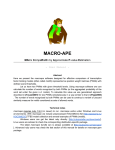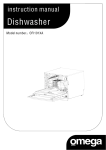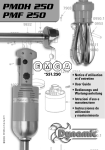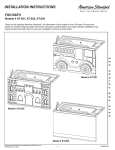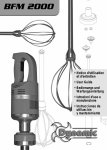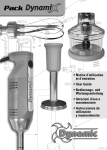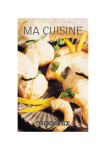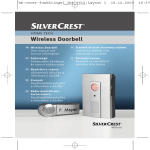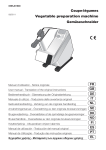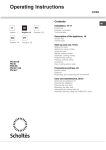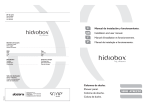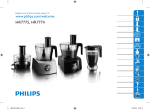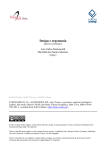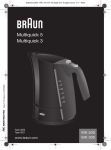Download First report prva stran
Transcript
European Global Product Realisation 2010 Handblender for men First project review March 18th, 2010 Team 2 János Sofalvi Jernej Marolt Dino Anić Tea Tadej Jozsef Szabo Krunoslav Antonić Jure Penca Gregor Povše Coach Neven Pavković Table of contents 1 Preface............................................................................................................................... 3 2 Abstract ............................................................................................................................. 3 3 Project assignement and overview .................................................................................... 5 4 Information model ............................................................................................................ 7 5 A short presentation of the company ................................................................................ 8 6 Research on the functions of the existing product .......................................................... 10 6.1 Definitions of functions ........................................................................................... 10 6.2 Overview of some existing appliances and their tools............................................. 11 6.2.1 Hand blenders .................................................................................................. 11 6.2.3 Blenders ........................................................................................................... 12 6.2.4 Mixers .............................................................................................................. 13 6.2.5 Multi function kitchen appliance: MUM4 ....................................................... 13 6.2.6 General conclusion about the existing hand blenders regarding the tools and functions .................................................................................................................... 14 6.5 Function goals .......................................................................................................... 15 7 Technical background ..................................................................................................... 16 7.1 Materials .................................................................................................................. 16 7.2 Manufacturing .......................................................................................................... 17 7.3 Engines, power, lifespan and energy supply ............................................................ 17 8 Ergonomics and design ................................................................................................... 17 8.1 Instructions for the use of a hand blender ................................................................ 17 8.2 Cleaning ................................................................................................................... 19 8.3 Design ...................................................................................................................... 20 8.3.1 Hand blenders .................................................................................................. 20 8.3.2 Bosch design ......................................................................................................... 24 9 Environmental aspect ...................................................................................................... 26 10 Analysis of products on curent market and patents ...................................................... 27 Patents ................................................................................................................................ 30 11 Men in kitchen .............................................................................................................. 32 11.1 Men’s environment ................................................................................................ 33 11.3 Man’s kitchen......................................................................................................... 39 12 Analysis of the questionnaire ........................................................................................ 40 13 Conclusions and visions ................................................................................................ 44 14 Requirements list .......................................................................................................... 46 15 Design problem ............................................................................................................. 47 16 Literature ....................................................................................................................... 48 Appendix A - An example of the questionnaire ............................................................... 50 Appendix B ........................................................................................................................ 53 Appendix C ........................................................................................................................ 54 Appendix D ........................................................................................................................ 56 2 1 Preface In our fast-paced world, one of the more recent changes is the participation of men in preparing the food. As more and more men are feeling more comfortable in the kitchen, the manufacturers of kitchen appliances are looking for new devices to offer the “modern man”. The classic appliances, with a bunch of (relatively) complex supplementary parts and lengthy cleaning, are regarded as unsuitable for men. The Bosch – Siemens Home Appliances Company, with its ~40% share of the small appliances market, believes that in kitchen men prefer to use devices that have the basic shape of a hand blender, combined with all the functions other kitchen appliances have to offer. It is this task that we will try to achieve in this year’s EGPR project. To design, construct, evaluate and produce a hand blender, designed especially to answer the needs of our “modern man”. The group consists of 8 participants – two engineers from the Zagreb University, a designer from Ljubljana, 2 engineers from Budapest University and three more from Ljubljana. The BSH Company has specified a precise list of technical and other demands that our product must fulfill. All these demands are detailed in the next pages. 2 Abstract In our first report we concentrated on designating our goal in detail, starting with the functions, technical specifications and ergonomics of a standard hand-blender (to be used as framework in constructing our own). By researching the functions and the tools of the existing products, we gathered the functions and combined them in three segments that could probably be performed each with one tool. We also found some characteristics in processing different types of food that can be concluded from the shape of the tools. 3 With the intention of better understanding our problem, we performed a market research for our target audience. We also conducted a short a survey, with which we hope to get a glance at what an average male consumer looks for in a hand blender. A blender really will simplify blending soups – speedily, easily and to a good, smooth, uniform texture – and it can happily cope with as much as 1 liter of liquid at a time. Food processors are not always good for blending small quantities, so if you want a small amount of mayonnaise, hollandaise, breadcrumbs, pesto or anything else that needs some quick, brief blending, user will find a blender does a better job. Between handheld blender and food processor, with a hand-held blender user have to do a little more work. In the goblet of a full-blown blender the ingredients are pulverized at the press of a button in seconds; with the hand-held version user have to manipulate it into the corners of bowls and pans to make sure the blades are reaching all the parts they need to. Food processor can chop 450 g of onions in seconds and will therefore save masses of time. It can also chop other vegetables, fruits and nuts. With a special attachment, by the food processors, user can deal with cucumbers, apples, cabbages, potatoes and whatever needs to be sliced evenly and precisely. It can be even chosen thick or thin slices. What we already know, is that ergonomics is the adaptation of items to the user and to his needs and physical requirements. Every object can be better or worse ergonomically userfriendly, and our task is to adjust the hand blender to the user and all of the device’s dimensions to a man's arm. What is also known to us is that it is difficult to take time for cleaning, especially of household appliances that have a lot of parts and assemblies. If we can choose between time spent on cleaning the devices and free time for oneself, we want to choose the second. In addition to the survey we also did a research about men in kitchen. The kitchen is an essential place of our life. The family, friends or relatives are often together in this room. Everybody uses this place, of course each one according to their own habits. There are a lot of differences in the kitchen between genders. Men and women differ in their conduct in the kitchen, which is reflected in the use of devices. It's necessary to know the most important trends in kitchen and the features of men's objects. 4 3 Project assignement and overview When developing a new device for a certain part of the populace, we must take into account various factors. At the beginning, we have to get to know the consumer. This we try to achieve with a set of questionnaires and a research about today's man in kitchen. Second, we have to study the modern hand blenders, which is the device most similar to the product we will be developing. In this context we have the complete technical background, ergonomics ... Probably most importantly, we must also assure that (all) the technical demands and functions set forth by the BSH Company are fulfilled: The guidelines which should be considered during the development of such a new product: - Electrically driven (could be battery charged), with appropriate energy charging system, integrated into the device. - Performances of basic functions of the product (blending and chopping of food) should be excellent. - Ease of cleaning; round shapes, no sharp edges, indentations, hidden corners. - Easy and intuitive handling of the device. - The size of the device should be similar to the size of the devices on the market. - The handle of the device should be foldable to fulfill even more demanding operations. - Ergonomic shape to should provide optimum and well balanced handling. - Tools for different operations (blending, whisking, kneading …) should be designed into few (preferably one) adaptable multipurpose tool. - The fully functional tool must consist of one or maximum two parts. - The storage box for the device should fit into standard kitchen drawers. It should also have a handle for easier transportation. - The storage box can be a part of kitchen set, for example a mixing bowl. - More advanced control unit such as touch display can be considered 5 - The device should fulfil all security standards (e.g. safe engaging, sharp blades hidden). Source: EGPR, Handblender for men, dr.Marko Uplaznik, 18.2.2010. It is of course very likely that we will not be able to satisfy the whole (rather extensive) list of demands. Household appliances have been designed before and are being optimized for certain goal audience even now, as every big producer of these devices is trying to do its best to get its share of the market. Our goal is to go and try to come up with the best solutions that our resources and our time together on this project provide. 6 4 Information model Source: Own work 7 To maximize the efficiency of our studies we used designing methodology. First of all we created our project plan. We had to finish our first work in four weeks that’s why a good schedule is indispensable. Afterwards, we defined our research topics. To get a valid image about influencing factors, it’s necessary to look at it from every possible angle. We defined and searched after the following research topics: functions of the existing products, costumers’ demands, market research, product environment, technical background, design, ergonomics, environmental protection and company. All of these topics are globalized and it doesn’t depend on the local actualities, but not everything. That’s why we needed information about user's habits from each country. More than one hundred and twenty issues of questionnaires were created and filled. By the time we finished the researches we got a lot of information. The next step was the processing of obtained information. For example we just know from the process of the questionnaire that the people between twenty and thirty don’t like kneading. In this way we could create the hierarchy of the blender’s functions. To create a good design, it is useful to make a list of functional requirements. The most essential requirements must be defined. We have to fulfill these to satisfy the expectations. When we thought over the results of our researches and defined the conclusions, we tried to imagine and discuss our visions. It’s amusing to make brainstorming digitally, far from each other. After the whole research we had to define the actual design problem, and as designers, we will solve it. 5 A short presentation of the company The Bosch Siemens Hausgeräte (Bosch Siemens Home appliances) in Nazarje, Slovenia, is an affiliation of the Bosch Siemens Hausgeräte GmbH concern, which is situated in Munich, Germany. The company was established in 1970, when the Gorenje factory set up a division for the production of small household appliances in Nazarje with the intention of supplementing their production program. In the first year, 65 workers were employed at the company. Two years later the company started to cooperate with the Bosch concern. In 1986, an 8 independent company, called Small Household appliances d.o.o. (Slovenian: Mali gospodinjski aparati – MGA), was established under the frame of the Gorenje company. By 1987, the MGA Company was independently performing most of its business functions. The Bosch und Siemens Hausgeräte concern became a 100% owner of the MGA Company in 1993. At the same time, a center for production and research of small (engine-driven) household appliances was established at the MGA Company 1. In 1995, the entire construction department and the development of small (engine-driven) household appliances were relocated from Germany to Nazarje, Slovenia. In the same year, the company acquired the ISO 9001 standard (the standard assures up to this day, that the company is doing business in accordance with the international standards 2). Four years later, mainly due to the expansion of the sale and production assortment, the company’s name was changed into BSH House Appliances d.o.o. Nazarje. The Company, with its Bosch, Siemens, Ufesa and Gorenje brands, sells most of its products (around 90%) into the foreign, mostly western-European markets (ibid.). With an extensive reorganization in 2002, the Company became the most important link of the Food and Beverage business group, in the Home appliances division. The BSH Company in Slovenia is now the main development and sale center in the Home appliances division. It is responsible for the development, innovation and quality of the products and for their marketing and sale (B/S/H Hišni aparati, http://www.bshhisniaparati.si/default.cfm? Jezik=Si&Kat= 010203, 12.3.2006). The BSH Company’s development center is successfully connecting good experiences from the economy and scientific domain and is regularly cooperating with home and foreign universities - with the universities in Ljubljana and Maribor, the German Technische Universität Illmenau and the Josef Stefan Institute (B/S/H Hišni aparati, http://www.bsh-group.si/index.php?page=107435, 10.3.2010). 1 When selling the company to the Germans, the main condition being put forth by the Slovenian owners was that the research department is to be preserved in Nazarje, not shut down. 2 As an addition, the ISO 9002 standard was designed for the company, which is being yearly tested. 9 6 Research on the functions of the existing product We know different ways of processing food and for every way we can have different tools. The variety of tools gives us the variety of functions that one kitchen appliance contains. But in today’s fast world we want to have as little appliances and as little tools as we can to process a great variety of food, that’s why we are trying to combine different ways of processing to be done with a single and simple kitchen appliance and only few tools for it. Here we are gathering data about the existing functions, so we can fill the need to minimize the tools we need and make the process of preparing food simple and quick. 6.1 Definitions of functions First, we researched definitions of the food processing functions and concluded that some of them are alike and could be achieved with the same tool. For that purpose we gathered the basic functions in three combinations that could each have one tool. Combined functions Mixing: − kneading − mixing − whipping Blending: − pureeing − crushing − meshing Process description: Different ingredients have to be combined in a single uniform mixture without chopping any of them in the process. Process description: Different ingredients have to be combined in a single homogenous mixture in a way that some of them are cut in the process so the mixture is smooth. Type of food: Soft, powdery, liquid Type of food: Semi-hard or soft or liquid Cutting: − cutting − crushing − chopping − slicing − grinding Process description: One or more ingredients have to be processed in a way that they consist of smaller particles. Type of food: Hard or semi-hard We put some definitions in Appendix B. 10 6.2 Overview of some existing appliances and their tools 6.2.1 Hand blenders An immersion blender is a kitchen appliance to blend ingredients or puree food in the container in which they are being prepared. They may be used for pureeing soups and emulsifying sauces. Some can be used while a pan is on the stove. 1. Main tool: Æ blender stick • cuts and blends the food • for making puree, blending soups, spreads, crushing ice and soft food • to use in an separate vessel (sometimes directly in the cooking pot on the stove) 2. Whipping whisks: • mixing ingredients (powdery, liquid, very soft) without cutting them • for whipping cream, whisking milk, mixing the mixture for backing… • to use in an separate vessel always 3. Cutting blade: • to cut hard food, chop vegetables, meat, nuts • needs pre-cut food (depends on the size of the food) • comes with some instructions about how to cut, how long and how to prepare different types of food • always in a specific vessel for chopping 4. Grinding and slicing: • different plate-knives for different sort of slicing and grinding • specially designed container for processing food • dishwasher safe (except for the container) • has lots of parts to assemble 5. Kneading: • new from Braun in the year 2009. 11 • kneads dough on the base of max. 250 g of flour. Figure 1: Attachments of handheld blender 6.2.3 Blenders A blender is a kitchen appliance used to mix ingredients or puree food. Blenders are also used to prepare emulsions, such as mayonnaise, and cream soups. The term typically refers to a stationary, upright electrical device. Can be more powerful than hand blender. Figure 2: Blender 12 6.2.4 Mixers A mixer is a kitchen appliance intended for mixing, folding, beating, and whipping food ingredients. Mixers come in two major variations, hand mixers and stand mixers. 1. Main tool: whisks or wire whips • mixing ingredients without cutting them • whipping or beating cream • separate vessel (for all tools) 2. Dough hook for kneading. 3. It can have the blender stick Figure 3: Mixer Gorenje 6.2.5 Multi function kitchen appliance: MUM4 Figure 4: One type of multi function appliance from BOSCH • whipping (e.g. cream), • kneading (e.g. bread), • mixing (e.g. cookies) • rough stirring - blending 13 • cutting, grinding, chopping… Figure 5: Attachments of multi function appliances 6.2.6 General conclusion about the existing hand blenders regarding the tools and functions The hand blenders have various limitations, which we can extract from the user manuals. Usually the quantity of different sorts of food for the processing is small, because of the motor power (it gets smaller from processing soft food to processing harder food). All the tools are circular symmetrical because of the stability and the nature of the handling with the hand blender. The stability problem and the resistance of the harder food dictates the usage of a specially designed containers in which we insert the knives or kneading hook so that the support of the tool is well defined. The last two conclusions are important in processing hard food like meat, cheese and vegetables or making dough for bread. We can see that the accessories are mainly the same in all the models of hand blenders but the variety of food they can process differs by the power of the motor and quality of the blades. Next we can refer to the survey we had done and see that the hand blender is popular and people want to use it. The current situation is that the basic functions of the hand blender (blending, stirring, whipping) are used mostly, but other functions are desirable and would probably be used if people had them and the containers wouldn’t necessarily be big like with MUM4 because urban man mostly cooks for 1-2 people. 14 6.5 Function goals The BSH Company gave us some demands for this project, so we are at this point listing the ones that refer to the functions of the hand blender and next adding demands that we concluded from the research on the functions. BSH demands: 1. The hand blender should perform all the functions that MUM4 multifunctional appliance does 2. The maximum amount of food to process should be around 1kg of dough 3. Performances of basic functions of the product (blending and chopping of food) should be excellent. 4. Easy and intuitive handling of the device. 5. The handle of the device should be foldable to fulfill even more demanding operations. 6. Tools for different operations (blending, whisking, kneading …) should be designed into few (preferably one) adaptable multipurpose tool. 7. The fully functional tool must consist of one or maximum two parts. 8. The storage box can be a part of kitchen set, for example a mixing bowl. Demands based on research: 1. The hand blender should perform all the functions people want to use. 2. The maximum amount of food to process needn’t be more than for four persons, based on the survey we had done 3. There should be less attachments for the same functions 4. The tools should be easy to clean 15 7 Technical background In our project, we will be designing a product, similar to a standard hand blender. Therefore, we performed an analysis of the existing device, the basic construction, materials, the procedures, with which the parts are produced... The technical date will serve as a basis for our own device. 7.1 Materials The outer shell is made from Polypropylene, a thermoplastic material that has good resistance to fatigue and heat. The material has added anti-oxidants, to prevent polymer degradation. The outer part can also be made from ABS thermoplastics. The reduction gear and transmission parts are made from POM (Polyoxymethylene - commercial name Hostaform Delrin 100 ) reinforced with glass fibers and glass balls, to gain dimensional stability, reduce friction and withstand pressure-loads. Figure 6: Technical products made of POM The POM material is very popular in manufacture of home appliances (it has necessary certifications so it can be used in the food industry). The inner parts are colorless, as color-adding weakens the basic plastic material. The mixing leg and the accessories are stainless steel. The blade can be reinforced with titaniumplates. 16 7.2 Manufacturing The plastic parts are made with standard injection molding techniques. The holding part's rubbery surface (rubber on plastics) is achieved with 2-component injection molding. The inner parts can be combined with ultrasonic welding. The mixing leg and accessories are manufactured with standard steel – cutting techniques. 7.3 Engines, power, lifespan and energy supply The engine in a standard single-phase asynchronous. The engine can run on 350W - 700W, depending on which functions the blender is performing. The power source is standard 220V. A typical lifespan for a hand blender is 5 years. The machine derives the energy either from a standard 220V power source or a rechargeable battery. 8 Ergonomics and design Ergonomics is a discipline that deals with customizing the product for the user, so that it is more pleasant and acceptable for use. As the hand blender is used with one hand, arm and hand are the most important part of the body that must be ergonomic with the device. As we can not change hands, hand blender can be customized to hand user groups. In this case- it's a man- we should have in mind the size of men's hands, and we have put in appendix C the dimensions that we need to pay attention to. 8.1 Instructions for the use of a hand blender 1. To protect against electrical shock, do not put the motor body, cord or electrical plug of hand blender in water or other liquid. The detachable blending shaft of this appliance has been designed for immersion into water or other liquids. Never 17 submerge any other portion of this unit. If the hand blender falls into liquid, remove it immediately. 2. Do not reach into the liquid without unplugging the unit first. 3. This appliance should not be used by children. To avoid possible accidental injury, close supervision is necessary when any appliance is used by or near children. 4. Unplug from outlet when not in use, before putting on or taking off parts, and before cleaning. To unplug, grasp plug and pull from electrical outlet. Never pull the cord. 5. During operation keep hands, hair, clothing, as well as spatulas and other utensils away from attachments and any mixing container, to reduce risk of injury to persons, and/or damage to the appliance. A spatula may be used, but must be used only when the unit is not operating. 6. Do not operate any appliance with a damaged cord or plug, or after the appliance has malfunctioned or has been dropped or damaged in any way or is not operating properly. Return the appliance to the nearest repair center for examination, repair, or mechanical or electrical adjustment. 7. Remove detachable shaft from the blender before washing the blades or shaft. 8. Blades are SHARP. Handle carefully when removing, inserting or cleaning. 9. When mixing liquids, especially hot liquids, use a tall container or make small quantities at a time to reduce spillage, splattering and possibility of injury from burning. 10. To reduce the risk of injury, never place chopper/grinder attachment cutting blade on base without first putting prep bowl properly in place. 11. Be certain the chopper/grinder attachment cover is securely locked in place before operating appliance. Do not attempt to remove cover until blade has stopped rotating. 12. Check prep bowl for presence of foreign objects before using. 13. The use of attachments or accessories not recommended by the produces may cause fire, electrical shock, or risk of injury. 14. Do not use outdoors, or use for other than intended use. 18 15. Make sure the appliance is off, the motor has stopped completely, and the appliance is unplugged from outlet before putting on or taking off attachments, and before cleaning. 16. To reduce the risk of fire or electrical shock, do not operate any heating appliance beneath the mounting unit. 8.2 Cleaning HAND BLENDER Always clean the motor body and blending shaft thoroughly after using. Remove the blending shaft from the motor body. Clean the motor body only with a sponge or damp cloth. Do not use abrasive cleaners which could scratch the surface. To clean the blending shaft, wash by hand in hot water using mild detergent. Never immerse the motor body in water. When the appliance has malfunctioned or has been dropped or damaged in any way or it is not operating properly, return the appliance to the nearest repair center for examination, repair or mechanical or electrical adjustment. CHOPPER/GRINDER ATTACHMENT ghopper/grinder attachmanet To simplify cleaning, rinse the prep bowl, cover and blade immediately after use, so that food won’t dry onto them. Wash blade ring, plastic sheath, and prep bowl in warm soapy water. Rinse and dry. Wipe the underside of the chopper/grinder cover with a sponge or damp cloth to remove any food. Do not submerge the cover in water or place in the dishwasher. Wash the blade carefully. Avoid leaving it in soapy water where it may disappear from sight. If you have a dishwasher, you can wash the prep bowl blade assembly on the upper shelf. Insert the prep bowl upside down. Put the blade in the cutlery basket. Unload the dishwasher carefully to avoid contact with the sharp blade. Wipe the motor body and top of the cover with a damp sponge or cloth. Dry it immediately. Never submerge the motor body or the cover in water or other liquid. 19 WHISK ATTACHMENT whisk attachment To clean your whisk attachment, simply release the attachment from the motor body housing. Once the whisk is removed, detach the metal whisk from the gearbox by pulling pieces apart. To clean the gearbox, simply wipe with a damp cloth. To clean the metal whisk, wash with warm, soapy water or place in the dishwasher. Do not submerge the gearbox in water or any other liquid. 8.3 Design 8.3.1 Hand blenders There are many types of hand blenders with different shapes, colors and technical parameters but all of them have similarities in shape and structure. The reasons of these similarities are that they have the same functions, their technical content is similar and all of them have to fulfill the same ergonomic requirements. According to this, we can define some common characteristics in form and structure. All hand blenders have a nearly cylindrical motor block and a blending tool attached to it. The shape of the motor block is determined by the cylindrical electric motor and gear and is affected by the ergonomic requirements that make the blender easily and comfortably usable. The blending tool can be replaced by other tools (for example: a whisking tool), these tools have different forms depending on their functions. Hand blenders with smooth and feminine design These hand blenders are addressed to housewives so they have rounded feminine shapes and smooth edges. They are mainly white combined with some pastel colors. These products are usually the cheaper and simpler models of a brand nowadays. This style was very common among the different kitchen appliances until the new more elegant and minimal design trends have appeared. 20 Hand blenders with smooth and feminine design: Figure 7: Feminine designed hand held blenders Hand blenders with modern and elegant design The modern, minimal design kitchens are very popular nowadays. According to this, the blenders that fit into this environment are also very popular. These products are not feminine, they are more masculine and elegant and they reflect professionalism, modernity and simplicity. These products are usually the more expensive and more professional ones in the product line of a brand. Their shape is simple and more geometric. Their colors are elegant, usually black, white and grey with a shiny or satin finish surface. The polished and brushed stainless steel surfaces are also very popular. Hand blenders with modern and elegant design: Figure 8: Modern and elegant designed hand held blenders (1) 21 Figure 9: Modern and elegant designed hand held blenders (2) Products and environments with modern and elegant design: Figure 10: Examples of modern urban designs 22 Figure 11: Modern designed pencil Professional hand blenders The professional hand blenders used in big restaurants are highly functional. Their main characteristics are the high power, long lifespan, reparability, robust construction and reliability. The design of these appliances is simple and reflects the mentioned characteristics. These kitchen tools look similar to the electronic power tools we use in the workshop, their shape is simple and functional, their casing is usually monochrome and the products of the brand have the same characteristic color. Professional hand blenders by Dinamic: Figure 12: Hand held blenders for professionals Professional tools by Bosch: Figure 13: BOSCH`S professional tools 23 8.3.2 Bosch design The design of the products of Bosch reflects quality, longevity, innovation, functionality, modernity and dynamism. These characteristics are very important for the brand so they try to express them with all of their products. Home appliances The look of home appliances has to fit in our homes, so the products of Bosch express elegance along with quality, modernity and functionality. Bosch home appliances: Figure 14: BOSCH`S home appliances (1) 24 Figure 15: Figure 14: BOSCH`S home appliances (2) Tools Bosch has two product lines of power tools: industry products and DIY (do it yourself) products. The products of both product lines have highly ergonomic shape and they all express power, dynamism, quality and functionality. The difference is that the DIY tools have a more dynamic and trendy design, while the design of the professional tools focuses on functionality and quality so it is more simple and geometric. Bosch DIY tools: Figure 16: BOSCHS DIY tools Bosch industry tools: Figure 17: BOSCHS industry tools 25 9 Environmental aspect The life cycle assessment has information on the estimated overall environmental impact, including greenhouse gases, energy usage, and toxic releases. The blender falls under "Electric house wares and household fan manufacturing." The model is run with an economic activity of $1 million and analyzed both the energy usage as well as the greenhouse emissions. The table, which displays the energy usage calculations, is in Appendix D. The greenhouse emissions caused by the manufacturing of electric house wares such as a blender are below as well as the cost of power generation and supply and transportation. Below are the results: Table 1: Results of greenhouse emissions Sector GWP CO2 CH4 N2O CFCs MTCO2E MTCO2E MTCO2E MTCO2E MTCO2E 693 598 54.1 10.7 30.5 Power generation and 218 supply 215 0 0 2.62 22.7 3.58 19.1 0.028 0 Truck transportation 57.9 57.0 0.088 0.796 0 Iron and steel mills 57.9 57.9 0 0 0 Electric house wares and household fan manufacturing 53.5 53.5 0 0 0 Total for all sectors Waste management and remediation services From this analysis, the overall environmental impact during use of a blender is much less than the manufacturing and transportation costs. A regular customer is consuming electricity while using the blender and it emits a negligible amount of heat and noise energy when considering the whole environment. Therefore, decreasing the environmental impact should be focused on manufacturing processes and decreasing the amount of natural gas used as it’s the area with the greatest amount of energy consumed. 26 Using the results from this analysis we have to be aware of impact which design phase of the project has in the complete picture, it exceeds 80 percent. Some of the main goals is the multifunctionality of hand blender. This is also a good DfE tool because we generally have one product with capability of several separate products and thus it's more ecofriendly. The number of materials used also should be decreased and device made mostly of HDPE. Usage of this material creates less environmental damage then some other polymers. Metal inserts in plastic parts should also be avoided and generally number of parts should be as low as possible. These are only some of the directions that should be followed during the design process in order to design environmentally friendly device. 10 Analysis of products on curent market and patents There is large number of manufacturers in the market. The most known manufacturers will be described in further text (some of their products). Existing products on market The Blenders that are on the market can be divided into two groups: • Handheld blenders • Standalone blenders Figure 18: Handheld blender BOSCH MSM75PRO Figure 19: Handheld blender BRAUN MR 6550 MFP 27 Figure 18 represents a BOSCH handheld blender. Engine power in this blender is 600 W. The engine is strong but quiet. The blender is ergonomically very good shaped and lies good in hand. Flexible spiral cable allows user to easily use and manipulate with device. The blender comes with a pot which has a measuring scale. This type of blender cannot provide electrical rpm adjustment. The price of this blender is around 100 €. All parts (except for parts of the engine) are suitable for cleaning in the dishwasher. Whole blender weights 1,4 kg. Figure 19 shows a hand blender from a competitors firm Braun. Engine power in this blender is also 600 W with 15 different working speeds. Like by first blender at this one all parts (except for parts of the engine) are suitable for cleaning in the dishwasher. It has a modern ergonomic shaped handle. This blender costs approximately 150 €. Price of this blender is little higher because of large number working speeds. In Figure 20 is shown hand blender from a competitors firm Kenwood. The blender has a handle with 5 speed control unit. It comes with slicing and shredding disc, with a knife blade, bowl, non- slip removable base and storage unit. This blender has 700 W engine. Parts of this blender cannot be cleaned in dishwasher. Whole device weights 2,8 kg. Price of this blender goes up to 200 €. Figure 20: Hand held blender KONWOOD HB 794 Figure 21: Hand held blender PHILIPS 1364 28 In figure 21 can be seen Philips handheld blender. This blender has 2 speeds and 600 W engine. It contains chopper for herbs, onions, cheese and other. All accessories can be cleaned in dishwasher. This device weights 1,5 kg. Price of this blender is around 60 €. Another advantage of this mixer is the possibility of separating the basis of plug-ins with the click of a button. It can be seen comparation between few characteristics of handheld blenders of a different manufacturer (table 2), and in table 3 comparation between characteristics of food processors. Table 2: Common characteristics of all hand held blenders BRAUN 600 YES YES, 15 KENWOOD 700 YES YES, 5 PHILIPS 600 YES YES, 2 Weight [kg] Price [€] BOSCH 600 YES NO 1,4 100 1 150 2,8 200 1,5 60 Washing in dishwasher YES YES NO YES Engine power Cable RPM A second group is standalone devices. They will be described in further text. These types of devices are little bigger then handheld blenders, and have stronger engines. Therefore their prices are also a little bigger. Figure 22: Food processor BOSCH MUM6N21 Figure 23: Food processor KENWOOD FP586 Figure 24: Food processor PHILIPS HR 7775 In figure 22 is represented food processor Bosch. This food processor has 1000 W engine and 4 working speeds. It contains a bowl for mixing made of stainless steel. The device weights 8,5 kg. The bowl has a volume of 5,3 l. this device contains 15 different plug- ins that can be used in numerous types of food processing. This food processor cost around 400 €. 29 Figure 23 shows Kenwood`s food processor. It has 500 W engine. Contains a 1,5 liter bowl made of plastic material. It comes with 10 attachments suitable for all sorts of jobs. The engine has 2 speed settings and pulse function. This device can shred, slice, liquidize, juice and blend. Because of smaller engine power, worse materials and not so many plugins the price of this device is around 100 €. In figure 24 can be seen a food processor from a competitors firm Philips. This device has 1000 W engine. It has 10 accessories which allow user to do many different jobs. With ice pulse functions food can be chopped and crushed. Whit the adjustable slicing blade slices of food can be from 1 up to 7 mm thick. Price of this device is around 230 €. Table 3: Common characteristics of all food processors Engine power [W] Number of speeds Bowl volume [l] Weight [kg] Price [€] Number of attachments BOSCH 1000 4 5,8 8,5 400 KENWOOD 500 2 + PULSE 1,5 4,8 100 PHILIPS 1000 4 1,5 6,3 230 15 10 10 Patents During searching databases of patents protected by the American patent rights appeared to have some interesting patents that may help the development of our device. Figure 25: Patent US 7 172 334 Figure 25 represents an US 7172334 patent which is designed as two part hand held blender. The device can also be composed of three parts; therefore the third parts are 30 cutting blades that can be easily changed. First part is upper part that contains engine that get’s power trough cable. Lower part is suitable for use whit any of separate processers. Upper part must be ergonomically designed so it can fit into a human’s hand. Upper part can also have stabilizing handle giving the user more control over the movement of blender during work. Two parts can be connected with the slot and rotation of the upper and lower part. Another option is to connect two parts with the thread. Figure 26: Patent US D 572 075 Figure 26 represents an US D 572 075 patent. This patent enters into our analysis of the market primarily because of well-designed base. This base can be attached to the wall with screws. It is designed to ease access to each plug-in. This design of base allows storage of device so it will not interfere with performing daily tasks. This solution is also possible to prevent dripping water from wet parts. Figure 27: Patent US 6 523 990 In figure 27 is shown another patent protected by American patent rights. The upper housing portion of device can be shaped to fit snugly in the palm of user’s hand so as to provide a gripping handle for the hand blender. One of the advantages of this device is the 31 use of spherical bearings. The spherical nature of the bearings makes it more tolerant to miss-alignment of work shaft and housing due to manufacturing tolerances and operational stresses. The cover plate of hand blender includes a skirt that extends concentrically, to the aperture, and shaft seal located within the skirt. 11 Men in kitchen The kitchen is an essential place of our life. The family, friends or relatives are often together in this room. Everybody use this place, of course their own habits adequately. There are a lot of differences in the kitchen between the two breeds. Men and women are different and it seems on their object, too. For example the function of razor is similar, but their look is not. Figure 28: Different look of razors The professional kitchens in restaurants principally are used by men. At home the situation was changed. The boss of the kitchen is the women. What’s up if there isn’t any woman at home? If man has to do his food every day? A lot of corporations are searching the new ideas for the modern and single man, who is well-paid but has not enough time. The following picture shows a great imagine, how to make simpler the washing process. 32 Figure 29: Washer It’s a washing machine which functions like a hamper, too. If man is out of time, it’s possible to drop into the appliance the unwashed cloths from the other side of the living room. 11.1 Men’s environment There are a lot of product for men. For example cars, knifes and many different tools. This objects are able to give rise to interest in the man but in the women aren’t. Figure 30: Example of mans interests’ objects The development of differences started after the birth immediately. The boys get blue cloths and toy guns, the girls get pink cloths and dollies. The products for the man usually communicate the same things, for example: strong, exact, serious, complex, useable. The colors of man aren’t so loud like the woman’s. Under the evolution man should be great in hunting, fighting and thinking. It was necessary to get a woman. The women had to excel in something else. They had to be beautiful, alluring and domesticated to get a man. 33 These traits of people didn’t fade away just changed. Basically the men are different from women. That’s why men’s environment is contrary to women’s. But kitchen is used by both of gender, that’s why should we be sensitive for the differences between the men and women. 11.1 Kitchens 2010 I’d like to discuss five of the most important trends that I feel are, or will be soon, in our consciousness as we consider how we want to live in our kitchens. These are lifestyle trends, not the color of the month trend! Kitchens are once or twice in a lifetime projects, typically. We want to pay attention to new ideas, absolutely, but seek longevity in design and materials as well. Here’s what I see: Figure 31: Type of open floor kitchen Open Floor plan (Rooted In Love) - An open floor plan design concept comes to mind first, and quickly! We’re busy. We want to connect with our family and friends while we perform the sometimes mundane tasks we need to do in the kitchen. We’re also feeling more relaxed, less formal, yet desire more control of our spaces. Rooted in love, this lifestyle trend has influenced a further awakening toward an open floor plan. Taking charge of our family connections in our own home means designing our kitchens for easy, 34 efficient, communication across disparate spaces. A loft-like design concept is gaining momentum as a coordinated “designed” response to the need for communication in our homes. Products of quality to better relate (as well as to better serve their purpose) to surrounding living areas are seriously considered for their longevity and classic design, be they modern, traditional, or artisan. Figure 32: Type of kitchen adapted by user What’s Your Style? - I see a continuing movement toward tapping into one’s inner creativity, finding one’s personal expression. The gift from the internet gods to those redesigning a room or a home is the ability to find the nuance of our personal style online. Finding those nuanced products, ideas, methods, that speak to us, is a direct result of a fresh and new confidence, built up over recent years (with the help of the internet gods) and a trend that has recently accelerated in light of our very difficult last 1, 1/2 years. It tells us that our unique aesthetic sensibility is interesting as opposed to odd, that “mainstream” is not the be all end all to aspire to, to feel “safe.” Personal expression Is mainstream. Your personal style rules…and rocks. Personal expression aside, what many of us also seem to be moving toward is a warm, modern, feel with clean lines and simple design elements with an appreciation for design that is inspired by nature, and offers easy care as one advantage. We used to have one or two clear trends in kitchen design. Now 35 we have quite a few trends, sub trends, mixed trends. The trend landscape has changed dramatically, a good change. Figure 33: The chef’s kitchen The Chef’s Kitchen – We love fabulously fun cooking equipment, appliances designed in countless configurations offering any feature you can dream of, including cool high tech features and lots of color and finishes. We’re going to local farmer’s markets, and a desire for healthy foods of quality is also responsible for the renewed enjoyment of cooking. The grill pans, specialty knives, panini presses combined with an appreciation for the classics such as Le Creuset ovens as one example, bring us to a more sophisticated level in our culinary lives. We’re cooking at home again for family and friends with gusto! The “Healthy Kitchen”, connected in philosophy to the “Chef’s Kitchen” will include aging in place design/universal design principles (it’s own enormous trend/topic), non toxic surfaces, and appliances for healthy foods and homes such as steam oven, air scrubbing refrigerators, ventilation that automatically turns on/off, adjusting its speed, electronic on/off faucetry and many more innovations designed to create and enhance a healthy lifestyle in the kitchen. 36 Figure 34: The social kitchen The Social Kitchen - More than ever before, we want our kitchens to be social. So social, that I see islands becoming larger as walls continue to come down, even taking center stage to include a sink and a cooking appliance, and seating. I see soft furnishings (the kitchen sofa for example, a concept that I strongly believe in, which is raised to meet the breakfast room table) in the kitchen and is all about comfort. I see finishes and colors which do not match, but blend. Fireplaces and larger windows in width and height create an open feel and add architectural interest as they do in surrounding rooms. Alternative finishes, textures and products add sophistication. Good artwork, sconces (and other nontypical kitchen lighting) and media of any size/shape/type contribute to the feeling that one is truly in a living/social area. Multiple work stations providing optimal function for various social lifestyle situations will be designed into the space. A desire for real comfort is strongly connected to the social kitchen trend. 37 Figure 35: Kitchen "Environmental awareness" Environmental Awareness - No list, even a short one, would be complete without mentioning the importance of sustainable living in our everyday life and thinking sustainability in the products we select. Appliances have made enormous strides in energy conservation in recent years, and faucets and cabinetry, flooring, tile, and countertops are made with recycled or certified environmentally safe materials. Conserving water and energy is our collective goal. Energy saving lighting fixtures has made great strides as seen in CFL and LED fixtures. Yes, you can still have your glam touch with (energy saving) lights in your sink or countertop! Green design, in my opinion, does not work without longevity built into products. Longevity built-in, equals quality. More than a trend, real quality, as it always has, simply makes sense. Environmental awareness brings with it a desire to experience the natural character of wood species, natural textures in metals, stone, and fabrics. A parallel to this trend is enjoyment of hand crafted, artisan, items, an easing up from perfection, toward organic shapes and joinery. 38 11.3 Man’s kitchen There are a lot of corporation who recognized the importance of the single men’s lifestyle. It is well-paid and ascendant part of the community. The Porsche Design Group knows that. Porsche Design Group and Poggenpohl are collaborating on a kitchen "especially designed for men." "Our co-operation with Porsche Design enabled us to design a kitchen whose sleek and functional design language specifically addresses male customers," says the press release. As for actual design details? No-handle cabinets, aluminum finishes, hi-tech A/V system. Not sure what the male gender has to do with a lack of handles, but Poggenpohl's the oldest furniture brand in Germany, so we're sure they know what they're doing. Figure 36: Example of man`s kitchen Elmar Duffner, managing director of luxury-kitchen specialist Poggenpohl, says the kitchen's design has a "sleek and functional design language that specifically addresses male customers." 39 The aluminum design, clearly inspired by the look of Porsche's cars, gives the kitchen a futuristic look that Poggenpohl says "further emphasizes Porsche's philosophy of high performance, innovation and luxury." The room design is dominated by wood, in a choice of driftwood or dark oak finishes. The cabinets and doors are pressure-opening and have no handles. Included is an audio-video system equipped with a protected LCD module with digital and analog connections. 12 Analysis of the questionnaire 120 people have submitted the questionnaires and the following charts represent these results. The average age was 26, 9 years. Because of the specific task questionnaire was more directed to young men, 65 of them to be precise, but there was also 55 women included since their experience with kitchen appliances is larger and they can provide more useful information about different potential functions of any kitchen appliance. As an introduction we need to know if people prepare food by themselves or not. This chart shows that large amount of people prepare food almost on a daily basis what is definitely a good impetus for designing food processing appliance. 40 In modern young urban families and individuals living alone it is obvious that we don't need large impractical devices for food processing. We need appliance that is suitable for preparing food for very few people. Usage of food processing appliances 41 Hand blender usage This chart shows preferences of two types of users. First, of ones who have a blender but also for those who don't have a blender but would like to have one. Most of the users complained about the very difficult cleaning of appliances. Other problems require also some attention but are subject of slight improvements. 42 General trend in all consumer product fields is noticeable also in appliances. Users don't want to take their devices to repair; they rather prefer to buy new ones. What is also important to see, in the field of appliances it is not so easy to convince customers to buy new model just because it is new and better than the old one. New product in this field of products needs to be innovative in some way. Young users live faster; they live as singles or in two. They don't need big appliances for preparing food for 6 people, they need something that is small, easy to operate and fast in preparing food for a few people or just themselves. The results confirm that most of them prefer hand blender over standalone devices. 43 13 Conclusions and visions The functions of the hand blander differ from model to model which depends on how many different attachments the device has. We can see on the market that hand blenders are already capable of performing all the functions that a multi-functional appliance has, but on a smaller scale. The success of a function and the amount of food that a function can process depends on a motor power and quality of the tool. The variety of functions that one needs brings us many different tools, which means lots of different parts to assemble and clean. This is unacceptable for the lifestyle of a modern man, so our product design process should be oriented towards the simplification of the tools and producing only few tools and attachments that could perform all the functions that the urban man needs on his hand blender. From research of market competitive products and patents, we conclude that modern products have in most cases, "serious" performances. A modern men needs kitchen appliances to be small and not to bother him if he does not need it. A new product development must be oriented towards reducing the size but retaining the existing features and functions of the device. It is necessary to consider the possibility of construction devices for food preparation that are independent of connection on electric power. This type of devices can be used on fieldtrips to nature on let`s say barbecue. A hand blender designed for urban men should thus be a simple and very effective tool. It is compact and easy to use, to assemble and to clean, to become suitable for making food every day. It is powerful too because it needs to be capable to process even bigger amounts of ingredients. The device and its accessories do not require much storage space and they can be accessed easily. It is ready to use whenever it is needed and does not require any special preparation. The range of its functions is as wide as possible so it can be useful in many situations. It accomplishes all its functions perfectly and reliably. After usage, the device can be cleaned easily and fast. The appliance is ergonomic and can be used comfortably, safe so it does not cause accidents and its usage does not stresses the user’s body, and its user interface is simple and easily understandable. The product has an appearance that makes it attractive for men; it has a simple shape and reflects 44 professionalism, dynamism and reliability. Modern man will know how to use such an advantage. What we learned in the part concerning the technical background, is that a majority of the hand blenders are made from the types of plastic materials, one for the outer shell and the other for the inner parts. The main leg can be either from the same plastic as the inner parts, but in most cases it is from stainless steel, like the mixing blades. The technical procedure, with which the all the basic parts are produced, is injection molding (or, to be more exact, two-component molding). The engines and power source are standard and well known. In designing our own prototype product, we will have to take into account the above mentioned technical framework. The appearance of hand blenders is changing. In the past all kitchen appliances were addressed to housewives so they had a feminine look with rounded shapes and smooth edges, they looked like a housewife’s best little friend. The products with this kind of design still exist but they are the cheaper and simpler models of a brand. Nowadays, as a result of the popularity of modern and minimal design in the kitchen, the kitchen appliances have a simpler and more masculine appearance. These new hand blenders look elegant and reflect professionalism, modernity and simplicity. This design is characterizing the new and more expensive models. Feminine design is losing popularity even among the products that were not addressed to men. In the XXIst Century, the men’s environment was changed. In our vision the product is going to fulfill new demands which were modified by the recent changes. We imagine a compact set of tools like a toolbox in the workshop. If a man wants to do anything in the kitchen (like in the workshop), he first takes that appliance to start his work. The storage box for the device will present a compact answer for every challenge in the kitchen. This product is going to fit the brand of BSH and add a new dimension to the market of hand blenders. 45 14 Requirements list Table 4: List of requirements Requirement Level Usage and functions Perform needed processes (mixing, whipping, stirring, blending, B kneading, cutting, slicing, grinding) Tools simple to attach, to use and to clean B Less tools for all the needed functions (combining functions in D one tool) the tools should not dictate how strong must the user be (how B strong must you hold that the food will be processed ok) basic functions performed excellent B as little limitations for using the tools as possible D Technical parameters made from durable thermoplastic materials B can be powered either with an electric cord or have an own B battery the lifespan is around 5 years D Design attractive for men D fits into Bosch's design D fit into kitchen drawer D Ergonomics high level of ergonomics hand blender B safe use of hand blender B quick and safe cleaning B Environmental protection made of environmental friendly materials D 46 B Basic requirement L Level requirement D Desired requirement 15 Design problem As technology develops, newer and better devices are constantly made to make our lives easier and more comfortable. The kitchen is one of the most important places in our home and we do many activities there, so it is not a coincidence that a modern kitchen is full of different electric appliances. The Kitchen appliance used to be addressed only to women because traditionally housewives were the ones who cooked. But nowadays, more and more men are becoming familiar with the kitchen. Some of them are young and have an urban lifestyle so they need to prepare some food for themselves, and some of them cook by pleasure for friends. Our aim in this project is to design a suitable tool that a man would like to use in the kitchen, and that could inspire men for cooking. This tool should be simple and very effective. We have to design a handheld appliance that bears as many functions as possible, but is compact and can be used and stored easily. It is desired that the appliance has only one multifunctional attachment, or if it is not possible, it has as few simple attachments as possible. The tool needs to be handled easily; it should be easy to use, to assemble, to clean and to store. It should be safe. The appearance of the appliance should be attractive for men, and should reflect values that Bosch products represent. 47 16 Literature • http://www.ex-designz.net/cookingpreparationterms.asp, 12.3.2010 • http://en.wikipedia.org/wiki/Hand_blender, 12.3.2010 • http://en.wikipedia.org/wiki/Blender, 12.3.2010 • http://en.wikipedia.org/wiki/Mixer_%28cooking%29, 12.3.2010 • http://www.braun.com/global/household/food-preparation/handblenders/multiquick-artiste.html, 12.3.2010 • http://www.gorenje.si/gospodinjski_aparati/mali_gospodinjski_aparati/mesalniki_i n_sekljalniki?c=235796, 12.3.2010 • Bosch Siemens Home Appliences Group, http://www.bshgroup.si/index.php?page=116431 , 5.3.2010. • Wikipedia, http://en.wikipedia.org/wiki/Pivaloyloxymethyl , 11.3.2010. • http://www.bosch.com/content/language2/html/index.htm, 13.32010. • http://www.dynamicmixers.co.uk/ , 12.3.2010. • http://www.independent.co.uk/life-style/gadgets-and-tech/features/the-ten-besthand-blenders-1792067.html?action=Popup&ino=1 ,11.3.2010. • http://www.comparestoreprices.co.uk/mixers-&-blenders.asp ; March 05, 2010 • http://www.powermillblender.com/ ; March 05, 2010 • http://www.bosch-home.com/hr/proizvodi/pomo%C4%87-kodkuhanja/kuhinjski-aparati/MUM6N21.html?source=browse ; March 01, 2010 • http://www.consumer.philips.com/c/food-processors-mixers/aluminiumcollection-1000-w-hr7775_00/prd/gb/ ; March 03, 2010 • http://www.currys.co.uk/gbuk/kenwood-multi-pro-fp586-food-processor01565471-pdt.html?srcid=369&xtor=AL-1[Awin]&srcid=369&tag=Awin&xtor=AL-1-[Awin ; March 03, 2010 • http://www.ceneje.si/dom-in-vrt/kuhinjski-pripomocki/multipraktiki/braunpalicni-mesalnik-mr6550-mfp-hc_-_CX000E81B6?tab=pod ; March 01, 2010 • http://www.google.hr/patents ; March 10, 2010 48 • Susan Serra- Kitchen Design Trends for 2010 and Beyond • http://access.decorati.com/2010/01/08/kitchen-design-trends-for-2010-andbeyond/?utm_source=feedburner&utm_medium=feed&utm_campaign=Feed:+de corati/CTEO+(Access+Decorati), 2010 03 05 • http://www.eiolca.net/ , March 2010. 49 Appendix A - An example of the questionnaire EGPR, Group 2 Development of a compact handblender – Questionnaire 1. Gender • male • female 2. Age ___ 3. How often do you make food? • • • • every day every week every month rarer 4. For how many people do you make food? • • 1-2 more 5. What types of kitchen appliances do you have? • • • • • • • • • whipping machine kneading machine mixing machine stirring machine blending machine slicing machine grinding machine chopping machine other: ___ 50 6. If you have a handblender what do you use it for? • whipping • kneding • mixing • stirring • blending • slicing • grinding • chopping • other:___ 7.What types of other machines could be useful in the kitchen? • • • • • • • • • whipping machine kneading machine mixing machine stirring machine blending machine slicing machine grinding machine chopping machine other: ___ 8. What are the problems of your kitchen appliances? • • • • cleaning assembling safety other: ___ 9. Where do you store your kitchen appliances? 51 ___ 10. When do you buy new appliances? • • • • when the old one brakes down when the old one needs service when the old one is not aesthetic anymore when a new model is presented 11. Would you like to have a handblender or a standalone device? ___________________________________ Thank you for your patience! 52 Appendix B To get some ideas of what should an hand blender be capable to do, we gathered some definitions of the processes: • To mix: to combine or blend into one mass or mixture. • To blend: to thoroughly mix together soft or liquid substances to form a single smooth substance. • To knead: to mix and work into a uniform mass, as by folding, pressing, and stretching with the hands: kneading dough. • To whipp: to beat (cream or eggs, for example) into a froth or foam. • To grind: to crush, pulverize, or reduce to powder by friction, especially by rubbing between two hard surfaces: grind wheat into flour. • To cut: GRIND : to reduce to particles by cutting, crushing, or grinding. • To chop: to divide into small pieces with a knife or other sharp tool. • To mash : to crush, beat or squeeze food into a soft state by using a fork or a masher. • To puree [ pew ray' ] : To mash a cooked product to a fine pulp, usually by forcing it through a sieve or putting it into a blender. We checked an example of foods and preparation methods from the user manual of the hand blender so we can se some practical limitations: 53 Appendix C Man Woman Length of hand1 Soldiers USA Japanese English East Germans mm 194 Nd 189 189 SD 10 Nd 10 9 m 181 Nd 174 175 SD 9 Nd 9 9 Wrist widith 2 Soldiers USA Japanese English East Germans 90 Nd 87 88 4 Nd 5 5 80 90 76 78 4 5 4 4 Maximum width 3 Soldiers USA Japanese English East Germans Nd Nd 105 107 Nd Nd 5 6 Nd Nd 92 94 Nd Nd 5 6 Scope of joints 4 Soldiers USA Japanese English East Germans 214 Nd Nd Nd 10 Nd Nd Nd 186 Nd Nd Nd 9 Nd Nd Nd Scope of joint 5 Soldiers USA Japanese English East Germans 174 Nd Nd Nd 8 Nd Nd Nd 151 Nd Nd Nd 7 Nd Nd Nd Mm = milimeters, Nd = no data, SD = standard deviation Relevant data collected by Courtney (1984), Fluegel in sodelavci (1986), Garett i Kennedy (1971), Greiner (1991), Imrhan in sodelavci (1993) and Pheasant (1996) 54 Dimensions in degrees Bending arms wrist F Outstretched hand E Radial arm movement U Carpi shift hands R Turn up the forearm S Turn down the forearm P 5.c. Man 50.c. 95.c. 5.c. Woman 50.c. 95.c. 51 47 14 68 62 22 85 76 30 54 57 17 72 72 27 90 88 37 22 86 43 31 108 65 40 135 87 19 87 63 28 109 81 37 130 99 c = centil Mobility in the hand wrist and forearm (Kroemer in sodelavci, 1997) 55 Appendix D Sector Elec Tota Coal NatGa LPG MotGa Distillat JetFue Residua MkW l TJ TJ s TJ TJ s TJ e TJ l TJ l TJ h Total for all 8.62 0.503 sectors 2.37 3.64 0.23 0.560 5 0.809 0.194 0.245 Power generation and supply 2.04 0.457 0.00 0.000 0 0.000 0 0.078 Electric housewares and household 1.11 0.130 fan manufacturin g 0 0.599 0.00 0.301 8 0.049 0 0.006 Iron and steel 0.73 0.036 3 mills 0.03 0.632 4 0.00 0.005 2 0.004 0.000 0.024 0.41 Truck 0.001 transportation 5 0 0.009 0.00 0.060 1 0.343 0 0 Plastics material and 0.32 0.018 resin 0 manufacturin g 0.02 0.258 1 0.01 0.004 5 0.001 0 0.002 2.58 0.000 56
























































